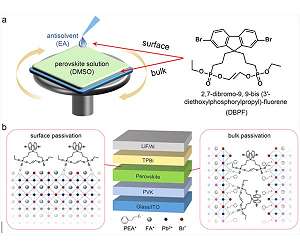Semiconducting perovskites that exhibit superfluorescence at room temperature do so due to built-in thermal “shock absorbers” which protect dipoles within the material from thermal interference. A new study from North Carolina State University explores the mechanism involved in this macroscopic quantum phase transition and explains how and why materials like perovskites exhibit macroscopic quantum coherence at high temperatures.
Picture a school of fish swimming in unison or the synchronized flashing of fireflies – examples of collective behavior in nature. When similar collective behavior happens in the quantum world – a phenomenon known as macroscopic quantum phase transition – it leads to exotic processes such as superconductivity, superfluidity, or superfluorescenece. In all of these processes a group of quantum particles forms a macroscopically coherent system that acts like a giant quantum particle.
Superfluorescence is a macroscopic quantum phase transition in which a population of tiny light emitting units known as dipoles form a giant quantum dipole and simultaneously radiate a burst of photons. Similar to superconductivity and superfluidity, superfluorescence normally requires cryogenic temperatures to be observed, because the dipoles move out of phase too quickly to form a collectively coherent state.
Recently, a team led by Kenan Gundogdu, professor of physics at NC State and corresponding author of a paper describing the work, had observed superfluorescence at room temperature in hybrid perovskites.
“Our initial observations indicated that something was protecting these atoms from thermal disturbances at higher temperatures,” Gundogdu says.
The team analyzed the structure and optical properties of a common lead-halide hybrid perovskite. They noticed the formation of polarons in these materials – quasiparticles made of bound lattice motion and electrons. Lattice motion refers to a group of atoms that are collectively oscillating. When an electron binds to these oscillating atoms, a polaron forms.
“Our analysis showed that formation of large polarons creates a thermal vibrational noise filter mechanism that we call, ‘Quantum Analog of Vibration Isolation,’ or QAVI,” Gundogdu says.
According to Franky So, Walter and Ida Freeman Distinguished Professor of Materials Science and Engineering at NC State, “In layman’s terms, QAVI is a shock absorber. Once the dipoles are protected by the shock absorbers, they can synchronize and exhibit superfluorescence.” So is co-author of the research.
According to the researchers, QAVI is an intrinsic property that exists in certain materials, like hybrid perovskites. However, understanding how this mechanism works could lead to quantum devices that could operate at room temperature.
“Understanding this mechanism not only solves a major physics puzzle, it may help us identify, select and also tailor materials with properties that allow extended quantum coherence and macroscopic quantum phase transitions” Gundogdu says.
The research appears in Nature Photonics and is supported by the National Science Foundation (grant 1729383) and NC State’s Research and Innovation Seed Funding. NC State graduate students Melike Biliroglu and Gamze Findik are co-first authors.
Research Report: “Room Temperature Superfluorescence in Hybrid Perovskites and Its Origins”
Related Links
North Carolina State University
All About Solar Energy at SolarDaily.com
|
We need your help. The SpaceDaily news network continues to grow but revenues have never been harder to maintain. With the rise of Ad Blockers, and Facebook – our traditional revenue sources via quality network advertising continues to decline. And unlike so many other news sites, we don’t have a paywall – with those annoying usernames and passwords. Our news coverage takes time and effort to publish 365 days a year. If you find our news sites informative and useful then please consider becoming a regular supporter or for now make a one off contribution. |
||
|
SpaceDaily Contributor $5 Billed Once credit card or paypal |
SpaceDaily Monthly Supporter $5 Billed Monthly paypal only |
|

![]()
Inhibiting thermal quenching of high-efficiency quasi-2D perovskite LEDs
Changchun. China (SPX) Mar 29, 2022
Metal halide perovskites are characterized by low-cost, high photoluminescence quantum yield, and high color purity. In recent years, perovskite light-emitting diodes are developing fast, with promising applications in lighting and display fields. However, the ubiquitous thermal-induced fluorescence quenching in perovskite emitters lacks systematic research, and methods to suppress thermal quenching need to be further developed.
In a new paper published in Light Science and Application, a team of … read more
